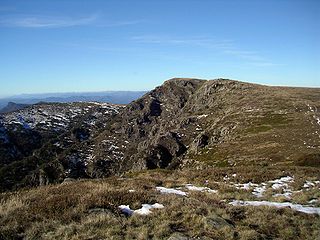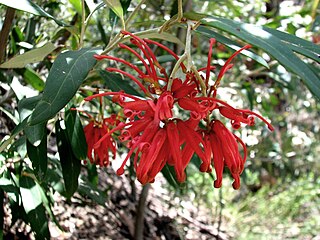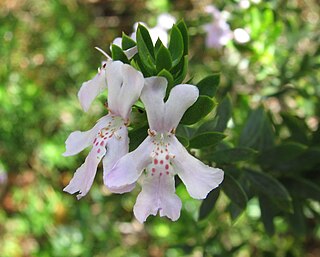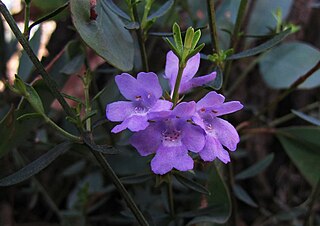
The Alpine National Park is a national park located in the Central Highlands and Alpine regions of Victoria, Australia. The 646,000-hectare (1,600,000-acre) national park is located northeast of Melbourne. It is the largest National Park in Victoria, and covers much of the higher areas of the Great Dividing Range in Victoria, including Victoria's highest point, Mount Bogong at 1,986 metres (6,516 ft) and the associated subalpine woodland and grassland of the Bogong High Plains. The park's north-eastern boundary is along the border with New South Wales, where it abuts the Kosciuszko National Park. On 7 November 2008 the Alpine National Park was added to the Australian National Heritage List as one of eleven areas constituting the Australian Alps National Parks and Reserves.

Epacris impressa, also known as common heath, is a species of plant in the heath family Ericaceae. It is native to south-eastern Australia. French botanist Jacques Labillardière collected the species in 1793 and described it in 1805. Four forms have been identified, but no subspecies are recognised. Growing in heathland, shrubland or open forest, it is generally a small shrub around 0.5 to 1 m tall, with small stiff leaves. The red, pink or white tube-like flowers appear from late autumn to early spring. Honeyeater birds, particularly the eastern spinebill, feed upon the nectar of the flowers. It regenerates after bushfire by seed or by resprouting.

The Mount Buffalo National Park is a national park in the alpine region of Victoria, Australia. The 31,000-hectare (77,000-acre) national park is located approximately 350 kilometres (220 mi) northeast of Melbourne in the Australian Alps. Within the national park is Mount Buffalo, a moderately high mountain plateau, with an elevation of 1,723 metres (5,653 ft) above sea level.

The Australian Alps are a mountain range in southeast Australia. The range comprises an interim Australian bioregion, and is the highest mountain range in Australia. The range straddles the borders of eastern Victoria, southeastern New South Wales, and the Australian Capital Territory. It contains Australia's only peaks exceeding 2,000 m (6,600 ft) in elevation, and is the only bioregion on the Australian mainland in which deep snow falls annually. The range comprises an area of 1,232,981 ha.

Baron Sir Ferdinand Jacob Heinrich von Mueller, was a German-Australian physician, geographer, and most notably, a botanist. He was appointed government botanist for the then colony of Victora, Australia by Governor Charles La Trobe in 1853, and later director of the Royal Botanic Gardens in Melbourne. He also founded the National Herbarium of Victoria. He named many Australian plants.

Westringia is a genus of Australian shrubs. As with other members of the mint family their upper petal is divided into two lobes. There are four stamens - the upper two are fertile while the lower two are reduced to staminodes. The leaves are in whorls of 3 or 4.

Grevillea victoriae, also known as royal grevillea or mountain grevillea, is a species of flowering plant in the family Proteaceae and is endemic to mountainous regions of south-eastern continental Australia. It is an erect to spreading shrub with elliptic to lance-shaped leaves, and pendulous clusters of red to orange flowers.

Grevillea alpivaga, also known as buffalo grevillea, is a species of flowering plant in the family Proteaceae and is endemic to a restricted area of Victoria, Australia. It is a shrub with crowded, linear leaves and pale green creamy-white flowers.
Celmisia tomentella is a species of perennial herb in the family Asteraceae. Leaves are 5 to 30 cm long and 5 to 15 mm wide, with a dark green or grey green upper surface. The daisy-like flowerheads, which are 6 to 8 cm in diameter, appear between December and February in the species native range. The species was first formally described in 1999 in New species and a new combination in Australian Celmisia (Asteraceae-Astereae) published in Australian Systematic Botany. It occurs in woodland, heath and bogs in subalpine areas including the Baw Baw plateau, the Bogong High Plains and Mount Buffalo in Victoria and northward into south-eastern New South Wales.

Veronica nivea, the milfoil speedwell or snow speedwell, is a flowering plant species of the family Plantaginaceae, endemic to south-eastern Australia. It is sometimes included in the genus Parahebe or Derwentia.

Westringia glabra, commonly known as violet westringia, is a flowering plant in the family Lamiaceae and is endemic to Australia. It is a small shrub with oval-shaped leaves and pinkish, mauve or purple flowers.
Westringia cremnophila, commonly known as Snowy River westringia, is a flowering plant in the family Lamiaceae, a rare shrub that is endemic to Victoria, Australia. It is a small shrub with leaves mostly in groups of three and white flowers.

Westringia crassifolia, commonly known as whipstick westringia, is a flowering plant in the family Lamiaceae and is endemic to Victoria, Australia. It is a rare shrub with narrow leaves and lavender-purple or pink flowers in spring.

Westringia eremicola, commonly known as slender westringia or slender western rosemary, is a flowering plant in the family Lamiaceae and is endemic to eastern Australia. It is a small shrub, with narrow leaves and pink, mauve to white flowers.

Westringia dampieri, commonly known as shore westringia, is a flowering plant in the family Lamiaceae, it grows in South Australia and Western Australia. It is a small, dense shrub with white, mauve, cream or purple flowers.

Westringia cephalantha is a shrub in the Lamiaceae family that is endemic to Western Australia.

Westringia rigida is a shrub in the Lamiaceae family that is endemic to Australia. and

Westringia longifolia, commonly known as long-leaved westringia, is a flowering plant in the family Lamiaceae and is endemic to southeastern Australia. It is a small shrub, with linear leaves and mostly white flowers.

Westringia tenuicaulis, also known as the Tufted Westringia, is a species of plant in the mint family that is endemic to Australia. Its natural range is restricted to the Fraser Coast Region of south-eastern Queensland, between Bundaberg and Sippy Downs.

Westringia lucida, also known as shining westringia, is a species of plant in the mint family that is endemic to Australia.


















